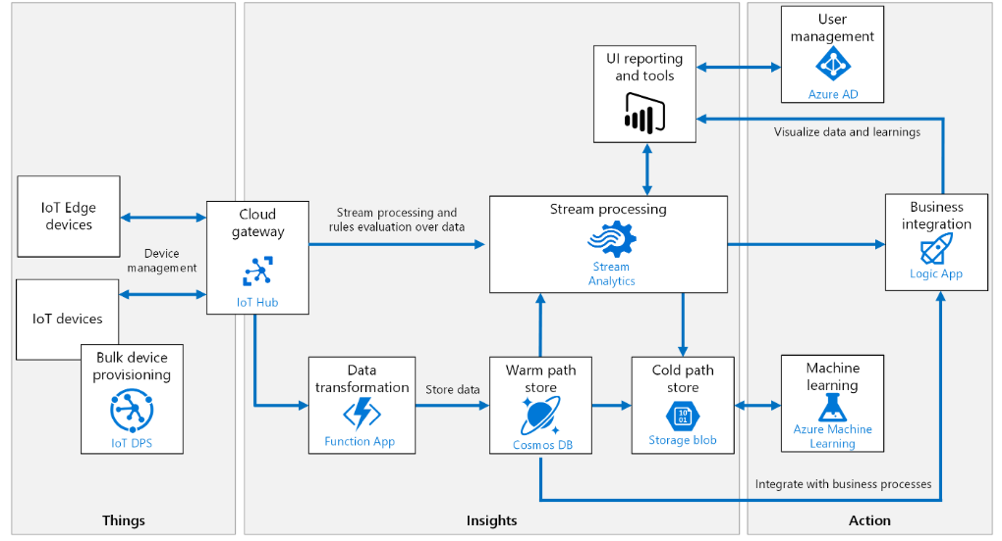The Internet of Things also called the Internet of Everything or the Industrial Internet, is a technology paradigm envisioned as a global network of machines and devices capable of interacting with each other. It is a network of Internet-connected devices that communicate embedded sensor data to the cloud for centralized processing. Here we build an end to end solution from device to cloud (see reference architecture diagram below) or an end to end IoT implementation of the application while covering all its aspects like alerting an Operator, shutting down a system, and more.
About the Microsoft Professional Program (MPP)
This program will teach you the device programming, data analytics, machine learning, and solution design skills for a successful career in IoT. It is a collection of courses that teach skills in various core technology tracks that helps you to excel in the industry’s latest trends. These courses are created and taught by experts and feature hands-on labs and engaging communities.
Benefits
A T Kearney: The potential for the Internet of Things (IoT) is enormous. It is projected that the world will reach 26 billion connected devices by 2020, with incremental revenue potential of $300 billion in services.
McKinsey & Co: The Internet of Things (IoT) offers a potential economic impact of $4 trillion to $11 trillion a year by 2025.
For a partner having these certified people can serve their customer whereas the developer can work on these projects and explore this new area.
MPP vs Microsoft Certification
The professional programs help us in gaining technical job-ready skills and get real-world experience through online courses, hands-on labs, and expert instruction within a specific time period. It is a good starting point to get your hands dirty with the technologies by learning via practical work, rather than classic certification style-based learning of reading a book. In MPP you be asked questions during the modules and you must complete all labs ready for the module exam where you will have to setup a solution from scratch and if your solution is correct only then will your answers be correct.
This program consists of eight different courses.
- Getting Started with IoT
This is a basic generic IoT course that provides an idea about IoT eco system or broad Perspective about IoT, it covers the concepts and patterns of an IoT solution and can be used to support business needs in industries like Manufacturing, Smart City/Building, Energy, Healthcare, Retail, and Transportation components of an IoT Architecture - Program Embedded Device Hardware
Here you will learn the basics for programming resource-constrained devices. In addition to that you will get some programming best practices that can be applied when working with embedded devices and you will get practice developing code that interacts with hardware, SDKS, devices that connect to various kinds of sensors. - Implement IoT Device Communication
Explains the Cloud Gateway or Azure IoT hub which helps in, Connecting and Manage IoT devices also helps in configuring them for secure cloud communication. Azure IoT hub helps in implementing secure 2-way communication between devices and the cloud, provision simulated devices using client tools such as Azure CLI and preforming management tasks while examining aspects of device security, Device Provisioning Service and how to provision devices at scale. - Analyze and Store IoT Data
Analyzing data, how to store it and able to configure the latest tools and implement data analytics and storage requirements for IoT solutions. Explains the concepts related to cold storage and set up Azure Data Lake for cold storage. Analysis and concepts for warm storage. Using Azure Cosmos DB as an endpoint to receive data from Azure Stream Analytics jobs and analytic capabilities of the Azure edge runtime. Set up stream analytics, to run on a simulated edge device, stream analytics querying, routing and analysis capabilities. - Visualize and Interpret IoT Data
In this course we can explore Time Series Insights. Real-Time Streaming, Predictive models data visualization tools, how to build visualizations with Time Series Insights, and how to create secure Power BI Service Dashboards for businesses characteristics of time series data – how it can be used for analysis and prediction. How IoT telemetry data is typically generated as time series data and techniques for managing and analyzing it with Azure Time Series Insights. Store, analyse and instantly query massive amounts of time series data. General introduction to using Power BI, with specific emphasis on how Power BI can load, transform and visualize IoT data sets. - Implement Predictive Analytics using IoT Data
Predictive Analytics for IoT Solutions through a series of machine learning implementations that are common for IoT scenarios, such as predictive maintenance.
Helps in describing machine learning scenarios and algorithms commonly pertinent to IoT, how to use the IoT solution Accelerator for Predictive Maintenance, preparing data for machine learning operations and analysis, apply feature engineering within the analysis process, choosing the appropriate machine learning algorithms for given business scenarios. Identify target variables based on the type of machine learning algorithm, evaluate the effectiveness of regression models. - Evaluate and Design an IoT Solution
Learn to develop business planning documents and the solution architecture for their IoT implementations. To build massively scalable Internet of Things solutions in an enterprise environment, it is essential to have tools and services that can securely manage thousands to millions of devices while at the same time providing the back-end resources required to produce useful data insights and support for the business. Azure IoT services provide the scalability, reliability and security, as well as a host of functions to support IoT solutions in any of the vertical marketplaces (industrial/manufacturing, smart city/building, energy, agriculture, retail, etc.). In IoT Architecture Design and Business Planning, you will be presented with instruction that will document approaches to design, propose, deploy, and operate an IoT Architecture. - Final Project
In this Project you should feel confident to start an IoT architect career and ability to design and implement a full IoT solution. In this project, you will get evaluated on the knowledge and skills that you acquired by completing the other IoT courses. Instead of learning new skills, we get assessed what we know with the emphasis placed on the hands-on activities. To leverage a real-world project scenario that enables us to verify that you have the skills required to implement an Azure IoT solution. The challenge activities section includes a series of tasks where you must design and implement an Azure IoT solution that encompasses many of the technologies. You will need to apply many different aspects of the training within your solution in order to be successful.
Real-World Scenario
Consider simulating a weather station located at some remote location. The station will send telemetry data to the cloud, where the data will be stored for long-term analysis and also monitored in real-time to ensure the wind speed does not exceed safe limits also unsafe wind speeds be detected, the solution will initiate an action that in the real-world would send alert notifications and ensure the wind farm turbines apply rotor brakes to ensure the turbines do not over-rev.
The functional requirements, constraints and the Proof of Value must satisfy.
- Every turbine in the simulated farm will leverage several sensors to provide the telemetry information relating to turbine performance and will connect directly (and securely) to a network that provides access to the internet.
- Demonstrate the use of Time Series Insights to view the wind turbine telemetry data.
- Route telemetry to storage appropriate for high-speed access for Business Intelligence.
- Create a dashboard in Power BI desktop that displays telemetry as lines charts and gauges.
Time Series Insight Graph










